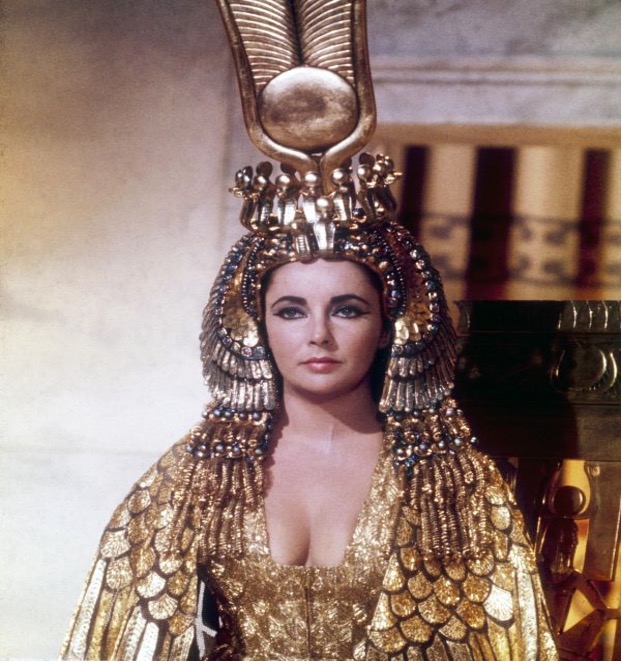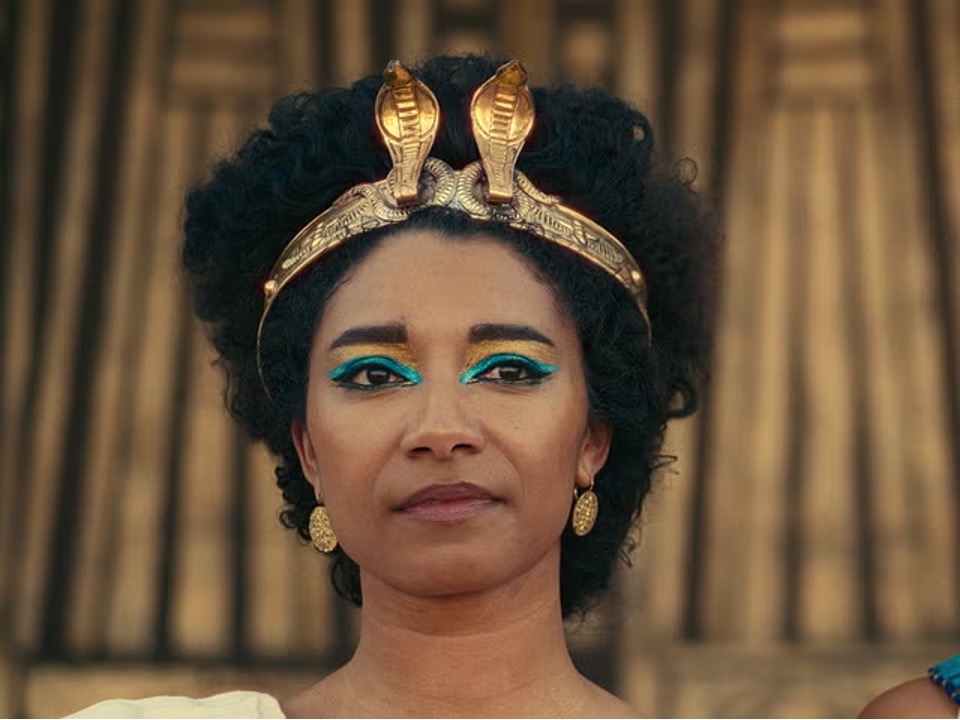Depictions of Cleopatra from Shakespeare to Netflix
Cleopatra VII (70/69 BC – 10 August 30 BC) was the last queen of Ptolemaic Egypt and is considered by many to be the last queen of Egypt proper before the Roman and later Islamic periods. Her death marked the end of the Hellenistic period, and she is commonly known as the lover of both Julius Caesar (12 July 100 BC – 15 March 44 BC) and Mark Antony (14 January 83 BC – 1 August 30 BC). Her imagery has gripped popular and creative imagination from the medieval period until today. This article will explore several key depictions of her in varying media.
Medieval Depictions
The first depictions of Cleopatra outside of antiquity are from the medieval and Renaissance periods. This material surpasses the scope of existent historiographic literature about her from classical antiquity and has had more of an impact on the public’s view of Cleopatra than the latter. The English poet Chaucer depicts Cleopatra and her relationship with Antony in The Legend of Good Women (1386) as that of courtly love, with Antony as her knight. This is an interesting comparison as it demotes Antony from a general and politician to that of a knight or soldier. Modern interpretations of the poem see it as a playful satire of courtly love. Surprisingly, Chaucer comments on Cleopatra’s relationships with only two men as hardly the life of a seductress.
In Dante’s Inferno, a segment of the Divine Comedy (1314), Cleopatra appears in Circle Two (Canto IV), the Circle of Lust. In this layer, all the inhabitants are punished for their lustful ways by being subjected to strong winds that make them unable to control their movements. This Canto is named the ‘canto of the queens’ as Dido, Helen of Troy and Semiramis also appear. This portrayal represents Dante’s strong medieval Christian ideals with Cleopatra contrasting against Beatrice, his pure ideal of a woman. Cleopatra is shamed in Dante’s Inferno for having two husbands, labelling her as not only a self-murderer but an adulteress.
Shakespeare
Shakespeare’s depiction of Cleopatra in Antony and Cleopatra (1632) is one of the most famous presentations and is often used as a basis for many modern versions. Due to its nature as a theatrical production, her portrayal is described by author Lucy Hughes-Hallett as being “only consistent only in her inconsistency. She is a woman as changeable as water: now jealous nag, now regal diplomat; now magnanimous lover, now self-serving schemer.” Shakespeare plays on the opposing views of Cleopatra as either a seductress or a skilled leader. Shakespeare’s depiction is based on the writing of classical author Plutarch, who wrote 200 years after Cleopatra’s time: Plutarch based his work on the memoirs of those contemporary to Cleopatra, including the memoir of her doctor. Plutarch gave credit to her as a linguist and leader, as well as comparing her to Venus, and this shows in Shakespeare’s depiction. However, the need to create an entertaining piece of theatre meant that Cleopatra had to be changed from production to production to make it fit the changing times.
Elizabeth Taylor
Released in 1963, Elizabeth Taylors’ depiction of Cleopatra is the most iconic, the film itself being 4 hours (251 minutes) long. The film’s production was notoriously chaotic and massively over its budget with the costumes and set designs comprising the majority of the cost. Taylor struggled with health issues throughout filming, and the film’s original cast all quit in anger. Despite this, the film is a cultural icon and is seen as a defining characteristic of 20th-century cinema. In the film, Cleopatra is depicted as megalomaniacal, wearing grand headdresses that were taken from real museum collections. Taylor’s costumes were notably low-cut and sexual, and her skin tone was lightened to appeal to Westernised beauty standards. The scantness of her costumes was worn despite Taylors’ poor health and complaints of the set’s coldness. This sexual treatment extended even to Taylor herself. In a famous scene where she bathes, the Scottish actor who played the blind poet gleefully recalled how the crew forgot he wasn’t blind. The costumes worn are almost an orientalist reimagining of the 1950s Hollywood golden age style, focusing on a slim waist and the defined modest curves that were in vogue at the time. The make-up can be similarly described as being a hybrid of what people thought Egyptian makeup was combined with distinctive eyeliner and eyeshadow shaping popularised by vogue IT girl and English model, Twiggy.

Carry on Cleo
Carry on Cleo was released in 1964, just one year after Elizabeth Taylor’s Cleopatra, and used the original sets from Cleopatra before it moved filming locations to Rome. Amanda Barrie’s character Cleopatra is often seen wearing a gold bikini and lounging around seductively. A notable scene has her taking a milk bath, something that Cleopatra reportedly did as a form of skincare. The film is a comedy, and arguably does this in self-awareness and parody. The film depicts Cleopatra as an ignorant and childish woman, relying on fluttering her eyelashes or unintentionally seducing other characters into doing things for her; this was all done in a comedic flanderised manner.
Assassin’s Creed
Appearing in the action-adventure game Assassin’s Creed Origins (2017), Cleopatra is featured as a non-playable character. She is first the employer of the two main characters, Bayek and Aya, before betraying them to side with Caesar. Her suicide is depicted as being assisted by the main characters and they are considered to have assassinated her according to in-game lore. The game depicts Cleopatra in a complex and multifaceted manner, with a whimsical, charming and seductive appearance that fits with her previous portrayals. However, beneath that, she is ruthless, cunning and power-hungry; willing to betray her allies to get ahead. Her negative characteristics largely derive from the game’s need to have a compelling story and villains that the players can recognise. However, the game gives credit to her intellectual abilities and her skills at realpolitik, possibly due to a paradigm shift in media and its portrayal of women. The game has been criticised heavily by Egyptologists and classicists such as Mary Beard and Joyce Tyldesley, finding fault with the game for relying on ‘Male Roman propaganda’ circulated by Augustus and his cronies to discredit Antony and Cleopatra and justify his own rule. This suggests the game’s depiction is less progressive than it appears on the surface.
Netflix’s Queen Cleopatra
Netflix’s Queen Cleopatra (2023) is a docudrama limited series depicting the life of Cleopatra through both actor and historian testimonies. However, upon release, the series quickly gained controversy due to the portrayal by British mixed-race actress, Adele James, of the infamous pharaoh, receiving over 250,000 dislikes on the trailer release on YouTube. Many viewers, especially Egyptians, complained that Cleopatra should not be black or mixed race, but white, claiming that this series was ‘blackwashing’ history and hiding indigenous Egyptians from history. This opinion was shared by many including the Egyptian antiquities minister, and stems from Cleopatra traditionally being shown in art as Greek. This can also be attributed to Cleopatra’s Hellenic roots (which could be characterised as ‘white’) and as evidence that Egypt was a racially diverse civilisation. Contrastingly, many take an Afro-centrist view and believe Cleopatra was not light-skinned, but actually was darker-skinned. An example of this is retired Classics and African studies professor Shelley Haley, who was involved in the docudrama, quoting her grandmother while enforcing her own belief of Cleopatra’s race: “I don’t care what they teach you at school, Cleopatra was black.” However, besides her Macedonian roots, Cleopatra’s lineage has been lost to time. Historians and archaeologists can only speculate what the Egyptian queen’s skin colour would have been. Rebecca Futo Kennedy, an associate professor of Classics at Denison University, stated that black and white is quite a modern concept and anachronistic to use in antiquity. Despite the series’ backlash, Adele James’ Cleopatra is depicted as a non-sexualised, strong, and intelligent woman trying to balance personal turmoil with political duty, creating an overall more positive view of the Pharaoh.

Conclusion
We have analysed only seven portrayals of Cleopatra out of hundreds, and through these, it can be seen that depictions change to fit the paradigm shifts and politics of the time, such as the change in feminist movements that happened in the 1970s. However, overall, Cleopatra is still depicted under the orientalist and, ultimately, male light that was first evident in descriptions surrounding her within classical sources.
Written by Leon Corneille-Cowell and Isabel Davies
Bibliography
Assassins Creed Wiki (2024). Cleopatra. [online] Assassin’s Creed Wiki. Available at: https://assassinscreed.fandom.com/wiki/Cleopatra.
Butcher, K. (2016). The Face of Cleopatra: Was She Really so Beautiful? [online] History Extra. Available at: https://www.historyextra.com/period/ancient-egypt/the-face-of-cleopatra-was-she-really-so-beautiful/.
Campbell, C. (2017). Assassin’s Creed Origins’ Promiscuous Cleopatra Is Just Plain Wrong. [online] Polygon. Available at: https://www.polygon.com/features/2017/11/2/16593124/assassins-creed-origins-cleopatra.
Collette, C.P. (2014). Rethinking Chaucer’s Legend of Good Women. Woodbridge, Suffolk, UK: York Medieval Press.
Fischer, W. (2022). The Production of Richard Burton and Elizabeth Taylor’s ‘Cleopatra’ Was a Glorious Disaster. [online] Collider. Available at: https://collider.com/cleopatra-elizabeth-taylor-richard-burton-production-history-explained/.
Fletcher, J. (2018). The Story of Egypt: the Civilization That Shaped the World. New York: W.W. Norton And Company.
Goldsworthy, A. (2010). Antony and Cleopatra. Hachette UK.
Hughes-Hallett, L. (2006). Article – About Cleopatra | Royal Shakespeare Company. [online] http://www.rsc.org.uk. Available at: https://www.rsc.org.uk/antony-and-cleopatra/about-the-play/article-about-cleopatra#:~:text=Shakespeare.
Irvine, A. (2023). Revisiting Cleopatra: Screen Portrayals of the Iconic Pharaoh. [online] History Hit. Available at: https://www.historyhit.com/culture/revisiting-cleopatra-screen-portrayals-of-the-iconic-pharaoh/.
Lansing, R. (2010). The Dante Encyclopedia. Routledge.
Latif, L. (2023). Queen Cleopatra review – the idea that you need a white actor is utterly insidious. The Guardian. [online] Available at:https://www.theguardian.com/tv-and-radio/2023/may/10/queen-cleopatra-review-a-fun-drama-weighed-down-by-the-self-serious-need-to-educate.
Lodge, G. (2023). Cleopatra at 60: The Expensive Epic That Almost Tanked a Studio. The Guardian. [online] 12 Jun. Available at: https://www.theguardian.com/film/2023/jun/12/cleopatra-60th-anniversary-elizabeth-taylor-richard-burton.
Roller, D.W. (2010). Cleopatra: A Biography. New York; Oxford: Oxford University Press.
Tims, A. (2013). How We Made Cleopatra. [online] The Guardian. Available at: https://www.theguardian.com/film/2013/jul/15/how-we-made-cleopatra.
Shakespeare, W. (1968). Antony and Cleopatra. Cambridge: Cambridge Univ. Press.
Sherwood, H. (2023). Cleopatra Was Light-Skinned, Egypt Tells Netflix in Row over Drama. The Guardian. [online] 28 Apr. Available at: https://www.theguardian.com/tv-and-radio/2023/apr/28/cleopatra-was-light-skinned-egypt-tells-netflix-in-row-over-drama.
